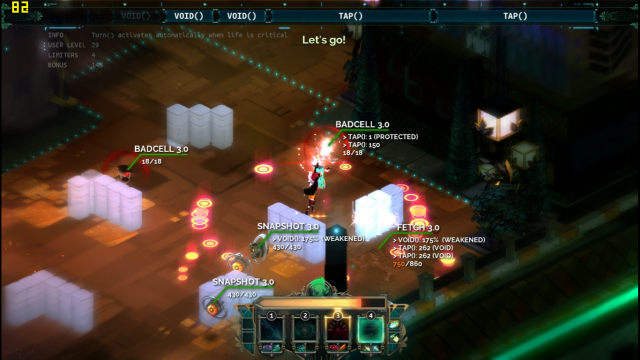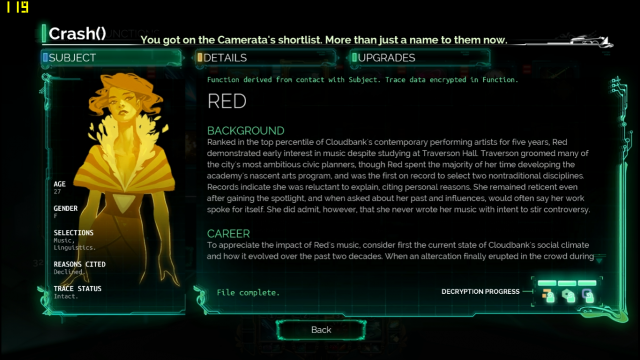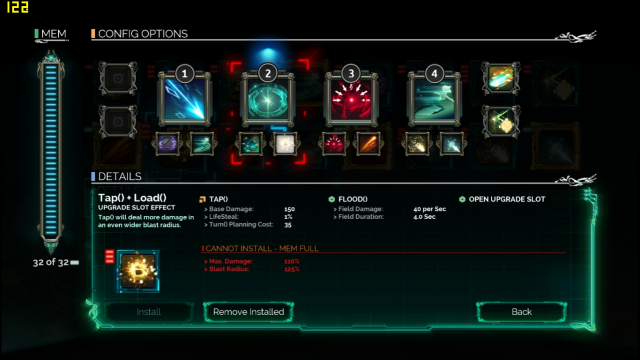Game: Transistor
Developer: Supergiant Games
Genre: Indie (Independent), Action, Role-Playing, Science fiction
Summary about the game
Red, a famous singer in the virtual city of Cloudbank, is attacked by the Process, a robotic force controlled a group who calls themselves Camerata. After being mysteriously teleported across Cloudbank thus surviving a clash, Red comes into possession of the mysterious Transistor, a sword-like weapon she was to be assassinated with. It was found buried into the chest of an unknown man who also teleported with her and seemingly close to Red. Though slumped over and dead, his conscious and voice seem to have been absorbed into the Transistor, along with Red’s voice. The Camerata continues to track down Red and the Transistor with the Process, wanting the weapon for unknown cause while turning Cloudbank into a blank state. It’s up to Red and her talking Transistor to find out the reason of her own assassination and hopefully reverse the “formatting” of Cloudbank.
Developer and game website: https://www.supergiantgames.com/games/transistor/
— What I’ve experienced and Felt from The Game
Elemental Tetrads: Aesthetics
The most obvious aesthetics of the game, for me, are its visual and sound aspects.
Visual: the game portrays probably one of the most colorful city I have seen. It’s not as dull as a typical white concrete jungle, beautiful yet uncluttered. It gives the player an impression like the game world is run on virtual, computer science principles, just like atoms and quarks in our world, yet the portrayal is not excessive to cater non-geeky gamers. Another examples are the naming conventions of transistor functions (typically called “abilities” in video games. Many computing motifs are used in this game) such as crash(). Brackets are appended, which programmers will immediately relate themselves to. Enemies’ names are also appended with version number such as Younglady 3.0.
 Fig.1: The scene just after executing turn(). The names of enemies are appended with version number that goes up as you progress the game.
Fig.1: The scene just after executing turn(). The names of enemies are appended with version number that goes up as you progress the game.
Sound: the soundtrack is one of the main reasons fans love the game. Mostly electronics by genre, although not as strong as expected. Felt like they are suitable for playing in coffee shops. The player can make Red hum with the background music at any time outside the battle. And inside the battle, the music is not strong as those we hear on triple A military shooting games, but it is enough to portray Red’s prowess. Music is filtered to be muffled while in turn(), a time-freezing battle planning mode.
Elemental Tetrads: Story
I consider the story to be the most important pillar of the game’s success as it greatly shapes the settings, motifs and visual aesthetics (Lens 78: Story). Supergiant Games has done beautifully in this regards. The story gave me a sense of curiosity, then twist, and eventually, bittersweet (Lens 1: Emotion). But there are more than just main story in the game. Each Transistor functions are also “traces” (like our “soul”) of an individual, therefore they also have biographies of individuals, including Red. Ordering a flatbread from Junction Jan’s on OVC terminal will later enable Red to go home a while and indulge as a side story narration of her time with the unknown lover absorbed into the Transistor.
 Fig.2: Red’s Biography in crash() function, while choosing Transistor’s attack function.
Fig.2: Red’s Biography in crash() function, while choosing Transistor’s attack function.
Elemental Tetrads: Mechanics
The two main gaming mechanics in the game are battle planning and managing transistor functions, which are suffice to finish the game and fulfill the experience (Lens 2: Essential Experience).
Battle planning: A battle can be fought with either a typical real-time manner or with a time-freezing planning mode named “turn()”. In turn(), everything is stopped except Red. A bar at the top measuring the total amount of Transistor functions that can be used and walking distance is displayed.
Transistor functions management: a function can be implemented as active (main ability. A Transistor can hold up to 4 of them), upgrade (enhances active function) or passive (enhances Red’s perk). There are a total of 16 distinct functions available that can make up to thousands of combinations.
One clever example is using switch(), a allegiance changing ability, as an active, or as an upgrade. Using switch() as an active function will change an enemy’s allegiance with a directional attack, and it takes up 1/3 of the turn() bar. However, if used as an upgrade of jaunt(), a short teleportation ability, Red can use jaunt() to teleport while triggering switch() by changing allegiance of enemies at the teleportation destination, at the cost of a jaunt(), which is 1/10 of the bar. In other words, two functions at a cheaper cost, albeit a shorter switch() duration. (Lens 49: Elegance)
 Fig.3: Configuring functions for transistors.
Fig.3: Configuring functions for transistors.
Elemental Tetrads: Technology
The game is available on PlayStation and Steam platform. In other words, keyboard, mouse or a PlayStation controller is needed to play the game. Generally, that means anyone with a decent computer with at least a dedicated graphics card can play this game smoothly.
This game is developed on MonoGame Engine, mainly based on Microsoft XNA API. Supports iOS, Linux, all of Microsoft’s platform, Android and PlayStation Mobile.
My gameplay video: http://youtu.be/Op03rI1b4FA
— What My Friend experienced and Felt from The Game
(Credits to my friend who is in fact the one introducing me to the game, Zee.)
Elemental Tetrads: Aesthetics
As a visual person, Zee is especially attracted to and likes the visual aesthetic of the game. She loves how simple the user interface was, and as an art design hobbyist herself, she likes how the artwork of the game is done. They look professional enough. She can also relate to the slightly geeky nature of the games’ settings and motifs.
As for the soundtracks, she likes the ambience. She thinks that there aren’t many battles in many other games with such not so action-oriented vibes.
Elemental Tetrads: Story
Curiousity (Lens 1: Emotion) is what driving her in the story. She is curious about the identity of the unknown man absorbed into the Transistor as a breach() function, the entire plot as of why Red is being hunted and the importance of the Transistor itself.
She finds the story beautiful when it comes to the bond between Red and her unknown man. The narration is mainly coming from the unknown man, who is more talkative and caring as Red can no longer speak for nearly the entire game, and certain parts from the members of Camerata. She finds such method of narration interesting.
Elemental Tetrads: Mechanics
She feels that the gameplay mechanics and the controls to the game are simple. She commented that she didn’t feel overwhelmed by the learning curve of the game.
One thing she likes about turn() is that the irrelevant background will be dimmed. What are highlighted in the game are Red herself, the combat area and border, the enemies and the obstacles for protection.
The levels are easy to navigate and mostly linear. There are no maps interface yet she didn’t feel lost.
Elemental Tetrads: Technologies
She is very used to playing the game entirely with the mouse. I usually use WASD keys on the keyboard to move Red while the attacks go to the mouse.
More on Lens 1: Emotion
She is especially annoyed with the teleportation and spawning of very weak doppelgangers of a particular enemy “process”, the Younglady. It’s a total wild guess to try to hit it again after it teleports using turn() unless several jaunt() (teleportation) and area-of-effect functions are pre-planned to get a lucky damage. That was what I taught her when she asked on the best way to deal with it quickly.
The happiest moment for her is always when Red levels up and acquires a new Transistor function.
— What I’ve learnt from Our Experiences
Achieve complex fun with simple ideas
It doesn’t take much of Transistor functions to make awesome combinations to drain enemies quicker. Also, it doesn’t take a complex learning curve to advance the entire storyline, given that this is mainly about Red’s journey to the truth. If this game had been made to be as complex as ARMA, a military simulation shooter game, it would’ve been unpopular.
Show what is relevant at a point of time to make gaming easy
Zee has pointed out on thing that I have totally missed, the dimming of environment in turn(). By dimming the environment, slow thinking gamers will be able to focus on relevant information at hand.
Make inside jokes more approachable for wider range of gamers, or feel like nothing at all
Given that the game has sold over 600k copies and has received 100 industry accolades within months, it is highly possible that this game has managed to attract non-computing people as well. We do not need to understand the meaning of the bracket behind each Transistor functions, and the version number is something that computer users will relate themselves to even if not all of them are software developers. A small spark of details is enough to give players rough generalizations of the settings.
If possible, make a game cater to wider gamer types and skills
The controls and learning curve were able to cater to Zee, who is mostly a fan of casual genre and spends more time on Pokemon on Nintendo DS, and me, who has lost count of how many games I’ve played since childhood. She was able to play the game with just a mouse, even though the game can be played with WASD keys.

